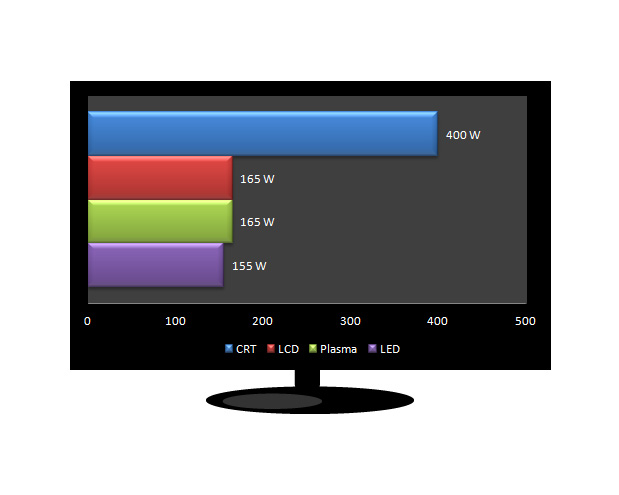The days are getting shorter and cooler, which will lead many of us to spend more time in the house watching our favorite shows or sporting events. A 2011 Nielson  report found the average American household owns 2.5 televisions and 31 percent of us have four or more sets in our homes. According to the National Resources Defense Council (NRDC), U.S. televisions use more than 46 billion kilowatt-hours (kWh) annually, or about 4 percent of total residential power consumption.
report found the average American household owns 2.5 televisions and 31 percent of us have four or more sets in our homes. According to the National Resources Defense Council (NRDC), U.S. televisions use more than 46 billion kilowatt-hours (kWh) annually, or about 4 percent of total residential power consumption.
But which type of television is the best when it comes to energy use? The most common found in our living rooms are the traditional cathode-ray tube (CRT) sets, plasma, LED (Light Emitting Diode) and LCD (Liquid-Crystal Display). You might be shocked to find out that of these four, it is the CRT that is the energy hog— drawing more power per unit of screen area than the other three.
Research conducted by E Source, an energy efficiency and technology company, in 2011 compared a 55-inch of each style for five hours in active, or “on,” mode. The CRT set used a staggering 400 watts (W) followed distantly by the plasma and LCD sets at 165 W and finally by the LED at 155 W. The data also revealed that the same televisions in standby mode (when the television is turned off, but still plugged in and drawing some power) for 19 hours a day, the CRT drew 8 W compared to the LCD drawing .4 W. And a 25-inch CRT used more power than a 35-inch LCD at 95 W and 65 W respectively.
Many find this hard to believe, as it was plasma TVs having a reputation for being major energy drains. There was some justification to this in the past, when an average model drew more power than a CRT or LCD, but today’s plasma draws nearly the same power as a comparable LCD in sizes larger than 31 inches.
Why the jump in efficiency? The increased manufacture of larger, flat screen televisions left the CRT to be, in essence, phased out of the commercial market when production ceased in 2007. This left plasma, LCD and LED models to follow many sets of revised energy standards set by Energy Star and state regulations.
Another energy drain connected to our home’s TVs is the increased use of set-top box receivers. More than 80 percent of us subscribe to some form of pay television service with approximately 160 million set-top boxes (including DVRs), nearly all of which are owned and installed by cable, satellite or phone providers. NRDC found that in 2010, these boxes consumed 27 billion kilowatt-hours (kWh) of electricity, or the equivalent of the annual output of nine average (500 MW) coal-fired power plants. They also noted that two-thirds of their annual energy usage occurs when people are not even watching or recording content.
So what can you do to increase your TV’s energy efficiency? It may be a good idea to replace your CRT set for a more efficient model. Be sure to look for Energy Star ratings and read labels to estimate the annual energy consumption. If you already own an LCD TV, turn down the backlight in the television’s settings—you’ll save energy and still retain picture quality. Also, if you have TVs in multiple rooms and use a set-top box, consolidate to a multi-room model. And if your TV or box provides a power saver mode, use it or unplug both devices when you go out of town.
